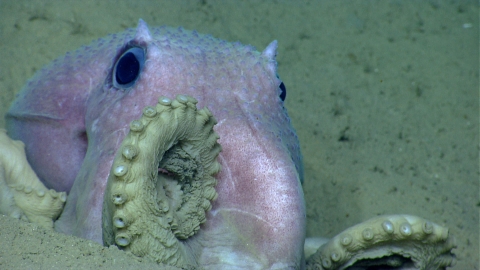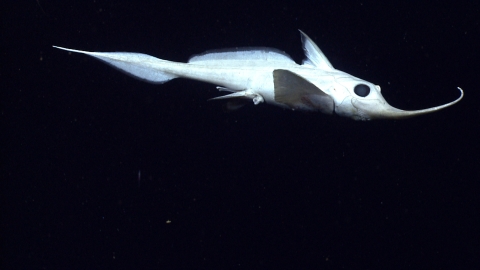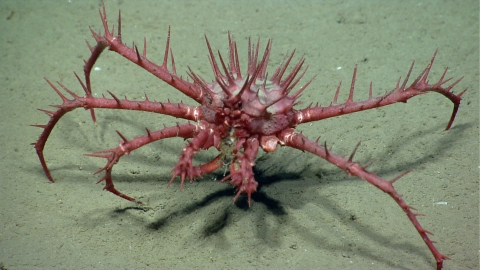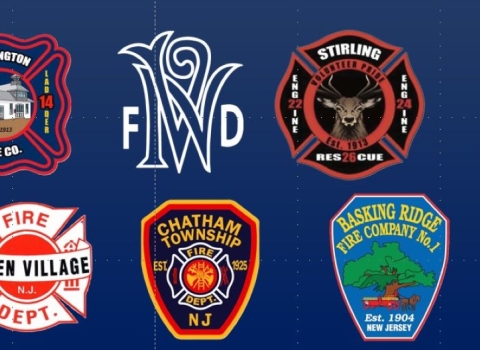Woolly mammoths and deep sea corals don’t appear to have much in common, but they have both called the Northeast Canyons and Seamounts Marine National Monument home. For woolly mammoths living over 12,000 years ago, the seamounts in the Monument were just ‘mounts’ rising up around river gorges that today we call deep sea canyons.
The Northeast Canyons and Seamounts Marine National Monument is a protected area located about 130 miles off the coast of Cape Cod. Four extinct underwater volcanoes — the seamounts — rise up to 7,700 feet above the ocean floor, making them taller than any mountain east of the Rockies. Three underwater canyons plunge 500 to around 7,700 feet deep where they intersect with the continental rise. The Monument’s Oceanographer Canyon is about 4,000 feet deep — the same average depth as the Grand Canyon!
Georges Bank is an elevated portion of the sea floor that separates the Gulf of Maine from the Atlantic Ocean. But during the last ice age, Georges Bank was an extension of the North American mainland and was home to many land dwelling animals, like woolly mammoths. Woolly mammoth bones have even been spotted on the surface of the seamounts in the Northeast Canyons and Seamounts Marine National Monument!
Fast forward thousands of years and the view from these mountains looks vastly different. Where woolly mammoths once roamed there is now a forest of corals and sponges.
Now an amazing underwater habitat, the canyons and seamounts are home to a myriad of creatures just as captivating as the land-dwelling animals that once roamed the area. Every time researchers visit the Monument they encounter species new to science!
We are all used to the idea of hiking up mountains and climbing down into canyons on land, but the idea of exploring these places deep under water where there is little light can be unnerving and even a little spooky. Many of the creatures seem weird to us because we’re not used to seeing or interacting with them. But spend a little time with some of the incredible creatures who call this place home and you may start to feel right at home there, too.
Dance like no one’s watching
Was this octopus putting on a show for the Remotely Operated Vehicle (ROV) cameras? Or did scientists just happen to catch it doing its daily calisthenics routine?
Perhaps this octopus is tasting something interesting in the water around it. Octopuses touch and taste with the suckers on their eight arms. Essentially they're tasting and touching their environment at the same time!
Octopuses are frequently seen on dives in the Monument and they are mesmerizing to watch. They live in shallow and deep ocean waters all over the world, and they are incredibly intelligent, charismatic and observant. They use tools to catch food and can build shelters — and they are even able to open jars.
The nose knows
We don’t know a lot about Rhinochimaera, but there are three species of these ancient deep sea fish and they live in oceans all over the world.
Their “noses” have sensory nerve endings that may help them to find food. Every once in a while commercial fishers will pull one up from the deep, usually resulting in a lot of terrifying images of a dead, creepy looking fish.
But don’t fall into the trap of thinking that deep-sea fish are gruesome just because of what they look like after having been pulled to the surface. They live in a high pressure environment down in the deep; being pulled up quickly out of that high pressure world into one of much lower pressure can really mess up a perfectly beautiful body. Some have noted its uncanny resemblance to a certain dog from a Christmas/Halloween classic!
My, what big eyes you have
This bobtail squid isn’t very big, but it does have some beautiful, large peepers — all the better for capturing any small amounts of light that it might encounter. A little odd looking, perhaps… but maybe not all that different from some of your favorite Pokémon characters?
After a ‘Leg Day’
This deep-sea lithodid crab looks the way many of us feel after a leg day at the gym. This crab’s leg day must have been exceptionally rough because it is missing one leg altogether! It may be hobbling along the sea floor a little bit, but it also seems to be quite enjoying its meal. These deep sea crabs are a type of king crabs.
Interestingly, king crabs are more closely related to hermit crabs than to other crabs. They have large right-hand claws and their legs fold backwards, instead of forwards. This means that they can walk straight forward, instead of the sideways shuffle that many crabs do.
The deep-sea lithodid crab’s red coloring may help to camouflage it from predators, as many deep-sea animals don’t have the ability to see the color red. Red wavelengths just don’t penetrate very far into the water column and thus red colored animals are very hard to see in the deep.
A different kind of bamboo forest
We’re used to seeing bamboo forests on land, frequently pictured with a super cute panda chomping on some bamboo and looking serene. But what about underwater bamboo forests? There are many different kinds of bamboo coral and they tend to form tree-like structures with branches, though the bamboo whip coral in this picture is a species that does not form branches.
But corals aren’t plants at all; they are animals! Bamboo corals are known as octocorals, because the coral polyps have eight tentacles. They extend these tentacles out into the water to grab plankton and other food particles.
This group of corals were given the common name “bamboo coral” by early scientists because all of the species in this group have an internal skeleton that has both dark black/brown proteins alternating with sections of calcium carbonate, which is white. The alternating colors in their skeletal structure structure
Something temporarily or permanently constructed, built, or placed; and constructed of natural or manufactured parts including, but not limited to, a building, shed, cabin, porch, bridge, walkway, stair steps, sign, landing, platform, dock, rack, fence, telecommunication device, antennae, fish cleaning table, satellite dish/mount, or well head.
Learn more about structure reminded early biologists of bamboo.
Moments of zen
Having a rough day? Tired of scrolling through endless articles about how to practice self-care?
Maybe it’s time to take a break from your above-ground life for a bit and Zen out in the deep-sea with some corals.
Deep-sea corals are colonies of small animals that build a common skeleton and they live from 150 feet to more than 10,000 feet below sea level. They form gardens of tree, feather, column, or fan shapes that can sometimes be dozens of feet tall!
They don’t know anything about pandemics or finances or interpersonal human relationships. They are just down there in the deep, living their lives, putting their tentacles out to find food, reproducing and slowly growing into giant colonies. The oldest deep sea coral colonies are over 4,000 years old, maybe it’s time to take in their wisdom to let go and go with the flow…
Shallow water corals use sunlight and warm temperatures to grow algae for food. But deep-water corals can’t depend on sunlight and they grab plankton and food particles floating by them with their tentacles. While shallow-water corals require sub-tropical and tropical ocean conditions, deep sea corals are able to live all over the world — even off the coast of Antarctica!
The Northeast Canyons and Seamounts Marine National Monument and its deep sea oasis may seem other-worldly, but you don’t have to travel to another planet — or even to a far away place on Earth — to get there. Sitting off the coast of Cape Cod, the Monument is only a few hundred miles from 25% of the U.S. population. So while the Monument may feel distant, in reality it is a deep sea playground sitting right in our backyard, just waiting to be explored.
This story was written by Lauren Bennett, a volunteer with the U.S. Fish and Wildlife Service.











